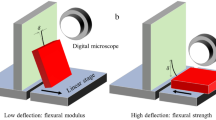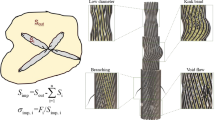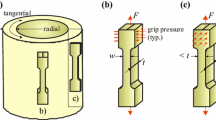Abstract
The scatter in tensile properties induced by the determination and calculation method of the cross-sectional area (CSA) of bast fibre bundles is almost as high as the scatter found in the literature. Different methods (light microscopy, high resolution flat-bed scanning, and laser-based fibre dimensional analysis) were applied to exactly the same flax fibre bundles prior to tensile testing, and different approaches for the calculation of the CSA were applied. The CSA method alone is introducing up to 300 % of variation in tensile strength data. These results show that there is a strong need for standards and standardisation of fibre bundle testing. Care has to be taken when comparing results from studies using slightly different methods.









Similar content being viewed by others
Notes
The pixel size can be calculated from the scanning resolution: Pixel size in mm = 25.4 mm/inch/scanning resolution in dpi.
Median (\( \tilde{x} \)) and Median Absolute Deviation (MAD) are given as distribution independent measures:
\( {\text{MAD}} = {\text{median}}(\left| {x_{i} - \tilde{x}} \right|) \).
References
Reux F, Verpoest I (eds) (2012) Flax and Hemp fibres: a natural solution for the composite industry. First edition, JEC composites prepared for JEC by the European Scientific Committee of the CELC, Paris, France (ISBN 978-2-9526276-1-0), p 215
Müssig J, Haag K (2015) 2—The use of flax fibres as reinforcements in composites. In: Faruk O, Sain M (eds) Biofiber Reinforcements in Composite Materials, Woodhead Publishing, Cambridge, (ISBN 978-1-78242-122-1), p 35–85
Joshi S, Drzal L, Mohanty A, Arora S (2004) Are natural fibre composites environmentally superior to glass fibre reinforced composites? Compos A Appl Sci Manuf 35:371–376
Dicker MP, Duckworth PF, Baker AB, Francois G, Hazzard MK, Weaver PM (2014) Green composites: a review of material attributes and complementary applications. Compos A Appl Sci Manuf 56:280–289
Baets J, Plastria D, Ivens J, Verpoest I (2014) Determination of the optimal flax fibre preparation for use in unidirectional flax–epoxy composites. J Reinf Plast Compos 33:493–502
Fischer C (2014) Thin-walled composite structures with improved stiffness and damping properties. Bioplastics Magazine 09:16–17
Shah D (2013) Developing plant fibre composites for structural applications by optimising composite parameters: a critical review. J Mater Sci 48:6083–6610. doi:10.1007/s10853-013-7458-7
Shah DU, Schubel PJ, Clifford MJ (2013) Can flax replace E-glass in structural composites? A small wind turbine blade case study. Compos B Eng 52:172–181
Baley C (2009) A review of biocomposite development. JEC Compos Mag 46:32–33
Bourmaud A, Ausias G, Lebrun G, Tachon ML, Baley C (2013) Observation of the structure of a composite polypropylene/flax and damage mechanisms under stress. Ind Crops Prod 43:225–236
Müssig J, Fischer H, Graupner N, Drieling A (2010) Testing methods for measuring physical and mechanical fibre properties (plant and animal fibres). In: Müssig J (ed) Industrial applications of natural fibres: structure, properties and technical applications. Wiley, Chichester (ISBN 978-0-470-69501-1), p 269–309
Schnegelsberg G (1999) Handbuch der Faser: Theorie und Systematik der Faser. Theorien und Systeme in Technik und Ökonomie; Bd. 1. Deutscher Fachverlag, Frankfurt am Main, Germany (ISBN 3-87150-624-9), p 720. (in German)
Virk AS, Hall W, Summerscales J (2010) Failure strain as the key design criterion for fracture of natural fibre composites. Compo Sci Technol 70:995–999
Pillin I, Kervoelen A, Bourmaud A, Goimard J, Montrelay N, Baley C (2011) Could oleaginous flax fibers be used as reinforcement for polymers? Ind Crops Prod 34:1556–1563
Müssig J, Hughes M (2012) II—Flax reinforcements: fibres. In [1], p 39–60
Bos H, van den Oever M, Peters O (2002) Tensile and compressive properties of flax fibres for natural fibre reinforced composites. J Mater Sci 37:1683–1692. doi:10.1023/A:1014925621252
Bos H (2004) The potential of flax fibres as reinforcement for composite materials. Dissertation, Technische Universiteit Eindhoven, The Netherlands
Charlet K, Béakou A (2011) Mechanical properties of interfaces within a flax bundle—Part I: experimental analysis. Int J Adhes Adhes 31:875–881
Charlet K, Béakou A (2011) Mechanical characterization and modelling of interfacial lamella within a flax bundle. Proced Eng 10:906–991
Charlet K, Jernot JP, Eve S, Gomina M, Bréard J (2010) Multi-scale morphological characterisation of flax: from the stem to the fibrils. Carbohydr Polym 82:54–61
Nechwatal A, Mieck K-P, Reußmann T (2003) Developments in the characterization of natural fibre properties in the use of natural fibres for composites. Compo Sci Technol 63:1273–1279
Stamboulis A, Baillie CA, Garkhail SK, van Melick HGH, Peijs T (2000) Environmental durability of flax fibres and their composites based on polypropylene matrix. Appl Compos Mater 7:273–294
Astley OM, Donald AM (2003) The tensile deformation of flax fibres as studied by X-ray scattering. J Mater Sci 38:165–171. doi:10.1023/A:1021186421194
Kulkarni AG, Satyanarayana G, Rohatgi PK, Viayan K (1981) Mechanical behavior of coir fibres under tensile load. J Mater Sci 16(4):905–914. doi:10.1007/BF00542734
Mukherjee PS, Satyanarayana KG (1984) Structure and properties of some vegetable fibres—Part 1: Sisal fibre. J Mater Sci 19(12):3925–3934. doi:10.1007/BF00980755
Keryvin V, Lan M, Bourmaud A, Parenteau T, Charleux L, Baley C (2015) Analysis of flax fibres viscoelastic behaviour at micro and nano scales. Compos A Appl Sci Manuf 68:219–225
Guicheret-Retel V, Cisse O, Placet V, Beaugrand J, Pernes M, Boubakar ML (2014) Creep behaviour of single hemp fibres. Part II: influence of loading level, moisture content and moisture variation. J Mater Sci 50:2061–2072. doi:10.1007/s10853-014-8768-0
Bobeth W (ed) (1993) Textile Faserstoffe—Beschaffenheit und Eigenschaft. Springer-Verlag, Berlin, Germany (ISBN 3-540-55697-4), p 431
Placet V, Cisse O, Boubakar ML (2012) Influence of environmental relative humidity on the tensile and rotational behaviour of hemp fibres. J Mater Sci 47:3435–3446. doi:10.1007/s10853-011-6191-3
Stamboulis A, Baillie C, Peijs T (2001) Effects of environmental conditions on mechanical and physical properties of flax fibers. Compos A Appl Sci Manuf 32:1105–1115
Baley C, Morvan C, Grohens Y (2005) Influence of the absorbed water on the tensile strength of flax fibers. Macromol Symp 222:195–202
Haag K, Müssig J (2013) FIBRAGEN—Flax for Improved Biomaterials through applied Genomics: New concepts to characterize the mechanical properties of flax fibre bundles. ResEff 2013—International Conference on Resource Efficiency in Interorganizational Networks. 13–14 November 2013, Georg-August-Universität Göttingen
DIN EN 1007-4 (2004): Hochleistungskeramik—Keramische Verbundwerkstoffe—Verfahren zur Prüfung der Faserverstärkungen—Teil 4: Bestimmung der Zugeigenschaften von Fasern bei Raumtemperatur; Deutsche Fassung EN 1007-4:2004. Deutsche Norm (08/2004). (in German)
XP T 25-501-2 (2009): Normalisation francaise: Fibres de renfort—Fibres de lin pour composites plastiques. Partie 2: Détermination des propriétés en traction des fibres élémentaires. Norme expérimentale. AFNOR (10/2009). (in French)
XP T 25-501-3 (2010): Normalisation francaise: Fibres de renfort—Fibres de lin pour composites plastiques. Partie 3: Détermination des propriétés en traction des fibres techniques. Norme expérimentale. AFNOR (07/2010). (in French)
Defoirdt N, Biswas S, Vriese LD, Tran LQN, van Acker J, Ahsan Q, Gorbatikh L, van Vuure A, Verpoest I (2010) Assessment of the tensile properties of coir, bamboo and jute fibre. Compos A Appl Sci Manuf 41:588–595
Tanguy M, Bourmaud A, Baley C (2016) Plant cell walls to reinforce composite materials: relationship between nanoindentation and tensile modulus. Mater Lett 167:161–164
Thomason J, Carruthers J (2012) Natural Fibre Cross Sectional Area, Its Variability and Effects on the Determination of Fibre Properties. J Biobased Mater Bioenerg, 6, 424–430
Aslan M, Chinga-Carrasco G, Sorensen BF, Madsen B (2011) Strength variability of single flax fibres. J Mater Sci 46:6344–6354. doi:10.1007/s10853-011-5581-x
Müssig J (2001) Untersuchung der Eignung heimischer Pflanzenfasern für die Herstellung von naturfaserverstärkten Duroplasten—vom Anbau zum Verbundwerkstoff—VDI Verlag GmbH, Düsseldorf, Germany (Fortschritt-Bericht VDI, Series 5, no. 630), (ISBN 3-18-363005-2) p 214. (in German)
Blanchard J, Sobey A, Blake J (2016) Multi-scale investigation into the mechanical behaviour of flax in yarn, cloth and laminate form. Compos B Eng 84:228–235
Virk AS, Hall W, Summerscales J (2010) Physical characterization of jute technical fibers: fiber dimensions. J Nat Fibers 7:216–228
Bourmaud A, Morvan C, Bouali A, Placet V, Perré P, Baley C (2013) Relationships between micro-fibrillar angle, mechanical properties and biochemical composition of flax fibers. Ind Crops Prod 44:343–351
Charlet K, Jernot JP, Gomina M, Baley C, Bizet L, Bréard J (2007) Morphology and mechanical behavior of a natural composite: the Flax Fiber. 16th International Conference on Composite Materials, 2007
Morvan C, Andème-Onzighi C, Girault R, Himmelsbach DS, Driouich A, Akin DE (2003) Building flax fibres: more than one brick in the walls. Plant Physiol Biochem 41:935–944
Slootmaker T, Müssig J (2010) SEM Catalogue for animal and plant fibres. In: Müssig, J (ed) Industrial applications of natural fibres: structure, properties and technical applications. Wiley, Chichester (ISBN 978-0-470-69501-1), p 311–336
Haag K, Müssig J (2013) FIBRAGEN—Flax fibre for Improved Biomaterials through Applied Genomics. Poster presentation, PLANT 2030 Status Seminar, March 6–8, 2013, Kongresshotel am Templiner See, Potsdam
Virk AS, Hall W, Summerscales J (2012) Modulus and strength prediction for natural fibre composites. Mater Sci Technol 28(7):864–871; J Nat Fibers 7:216–228, 2010
Bensadoun F, Verpoest I, Baets J, Müssig J, Graupner N, Davies P, Gomina M, Kervoelen A, Baley C (2015) Development and validation of an impregnated fibre bundle test for natural fibres used as reinforcement in composites. In: Thomsen OT Aalborg University, Department of Mechanical and Manufacturing Engineering (Conference Chair): 20th International Conference on Composite Materials—ICCM20. Copenhagen, Denmark (19–24.07.2015)
Acknowledgements
We acknowledge the Federal Ministry of Education and Research for funding the project “FIBRAGEN—Flax for improved biomaterials through applied genomics” within the funding measure PLANT-KBBE III under the project code 0315911. Our special thanks go to Dr. Thomas Assheuer from Projektträger Jülich PTJ for his excellent support during the whole FIBRAGEN-project. We also acknowledge Yann Leray and Steve Bucknell from DiaStron Ltd. for their support and optimisations within the software. We thank Mr Erik Klebert, B.Sc. for his help with the experiments.
Author information
Authors and Affiliations
Corresponding author
Rights and permissions
About this article
Cite this article
Haag, K., Müssig, J. Scatter in tensile properties of flax fibre bundles: influence of determination and calculation of the cross-sectional area. J Mater Sci 51, 7907–7917 (2016). https://doi.org/10.1007/s10853-016-0052-z
Received:
Accepted:
Published:
Issue Date:
DOI: https://doi.org/10.1007/s10853-016-0052-z




